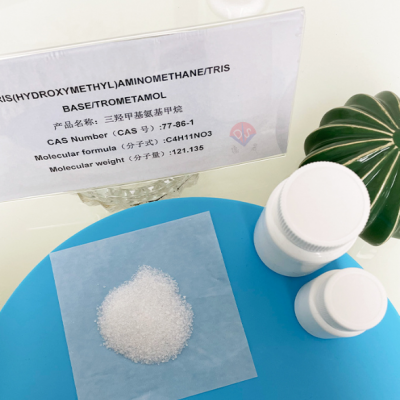Home > Products > Biological buffer > Why Should we Pay Attention to Solubility When Purchasing Biological Buffer TRIS 77-86-1?
Why Should we Pay Attention to Solubility When Purchasing Biological Buffer TRIS 77-86-1?
100 - 499 Kilograms
500 - 999 Kilograms
≥1000 Kilograms
- Shanghai
- T/T L/C PayPal Western Union
- 5 days
You May Like
-
The Effect of Purity of BICINE Powder 150-25-4 as a Biological Buffer on the Performance of Buffer Solutions
-
Introduction to the Transportation Packaging of CAPS Powder 1135-40-6, a Biological Buffering Agent
-
Compatibility of Biological Buffer MOPS 1132-61-2 With Other Reagents
-
Application of Biological Buffer TAPS 29915-38-6 in Enzyme Activity Research
-
The Advantage of High Purity of EPPS Powder 16052-06-5 Raw Materials for Biological Buffering Agents
-
Advantages of MOPSO Buffer 68399-77-9 in Low-temperature Biochemical Work
Product Details
| CAS No. | 77-86-1 |
Product Description
In biochemical and molecular biology experiments, buffering agents are the core tools for maintaining solution pH stability, and trihydroxymethyl aminomethane (TRIS) has become one of the most widely used buffering agents in laboratories due to its excellent buffering performance. However, many researchers often only focus on the purity or price of TRIS when selecting it, neglecting the key parameter of solubility. In fact, solubility is also an important factor affecting the feasibility of experiments, the accuracy of results, and operational efficiency.
1、 Solubility determines experimental adaptability: avoiding concentration limitations and pH deviations
The solubility of TRIS determines its maximum concentration that can be formulated. For example, in some enzyme activity assays or protein crystallization experiments, low solubility TRIS will not meet the requirements, resulting in limited experimental design, and insufficient solubility may cause undissolved particle precipitation, which can interfere with spectral analysis (such as UV absorption, fluorescence detection) or centrifugal separation steps, directly leading to data bias.
More importantly, the solubility of TRIS varies with temperature. If products with low solubility are used in low-temperature environments, even if prepared at conventional concentrations, crystallization may occur, resulting in actual buffer concentrations lower than theoretical values and pH drift, which seriously affects enzyme activity or cell culture efficiency.
2、 Solubility affects solution stability: preventing precipitation and performance degradation
TRIS with high solubility can ensure the uniformity of the buffer solution during long-term storage or under complex conditions. For example, in protein purification experiments, the buffer needs to coexist with various additives (such as salt, descaling agent, reducing agent). If the solubility of TRIS is insufficient, it may form complex precipitates with other components, block the chromatography column, or contaminate the sample.
The solubility is also closely related to the pH buffering range of TRIS buffer. The pKa value of TRIS is 8.1, and its effective buffering range is pH 7.0-9.0. If the solubility is insufficient, the actual number of TRIS molecules present in the buffer decreases, and the buffer capacity (ability to resist pH changes) significantly decreases. For example, in cell culture experiments, the buffer solution prepared with low solubility TRIS may not effectively neutralize the acidic substances produced by metabolism, resulting in a sudden drop in the pH of the culture medium, inhibition of cell growth, and even death.
3、 Convenience of solubility optimization operation: improving efficiency and reducing costs
TRIS with high solubility can simplify the preparation process and save experimental time. For example, when preparing TRIS buffering agents, TRIS powders with low solubility need to be dissolved step by step or assisted by heating, which is cumbersome and prone to introducing errors. And high solubility products can reduce dissolution time, avoid oxidation or moisture absorption problems caused by long-term stirring, especially suitable for large-scale production or high-throughput screening scenarios.
Hubei Xindesheng Material Technology Co., Ltd., as a professional manufacturer of TRIS and other biological buffering agents, has unique methods and insights for controlling various indicators of products, ensuring that customers receive products with excellent performance and all indicators meet relevant standards. Desheng adheres to the concept of "quality first, technology leading" in the production of every product. Customers at home and abroad can rest assured to purchase. If you have any related procurement needs in the near future, please feel free to contact me at any time!
Contact Us

- Hubei New Desheng Material Technology Co., Ltd
- Contact nameDoris Yang Chat Now
Product Categories
| Additive for blood collection | Biological buffer | Chemiluminescence reagent | Chromogenic substrate |
| enzyme preparation |
New Products
-
What Does HEPES Buffer 7365-45-9 do for Cell Culture
-
Application of Biological Buffer PIPES 5625-37-6 in Biochemical Research
-
How to Determine and Choose a BES Buffer 10191-18-1 Manufacturer for Procurement
-
Biological Buffer DIPSO (68399-80-4) Detailed Description for Quick Understanding
-
Multiple Applications of CHES Buffer in Biological Research
-
Advantages of High TOOS Molar Absorbance
-
How to Obtain High-quality TOPS Powder as a Chromogenic Substrate
-
Stability and Storage Conditions of ADOS Products as Chromogenic Substrates
-
The Simplicity of ADPS Colorimetric Reagent in Experimental Operation
-
Packaging Requirements for Exporting Color Developing Substrate ALPS Powder in Small Batches
-
What Items Can DAOS, a Chromogenic Substrate, be Used to Detect?
-
Basic Information of the New Trinder's Reagent HDAOS Powder Reagent
-
Application of MADB 209518-16-1 in Serum Muscle Enzyme Detection Kit
-
Exploration of the Advantages of MAOS Chromogenic Substrates in Biochemical Detection
-
You Need to Pay Attention to These Three Erroneous Views When Purchasing Carbopol Powder
-
What is the Use of the New Trinder's Reagent TOOS 82692-93-1?
-
Application Introduction of TOPS Color Reagent (CAS40567-80-4)
-
What Applications Can the Chromogenic Substrate ADOS 82692-96-4 be Used In?
-
What Are the Advantages of Using ADPS 82611-88-9 as a Chromogenic Substrate?
-
Application of Color Reagent ALPS 82611-85-6 in Biochemical Experiments
-
Preparation and Use of New Trinder's Reagent DAOS 83777-30-4 Solution
-
Advantages of HDAOS 82692-88-4 as a Chromogenic Substrate in Desheng
-
What is the Function of the Chromogenic Substrate MADB 209518-16-1?
-
What Are the Advantages of the Chromogenic Substrate MAOS (CAS82692-97-5)?
Popular Searches
Recommended Products
- Water Sample Mercury Ion (Hg²⁺) Concentration Assay Kit
- Nitrite Test Paper 0~100 Ppm
- On Site Rapid Detection of Surface Cleanliness of Catering Utensils
- Sodium Metasilicate Granular 25kg Powder
- Chlorine Dioxide Quick Test Kit
- Residual Chlorine Quick Test Kit
- Rapid Determination of Available Chlorine
- Quaternary Ammonium Sanitizer Concentration Test Strips [0~4000 Ppm]
- Quaternary Ammonium Sanitizer Concentration Test Strips [0~1000 Ppm]
- You Need to Pay Attention to These Three Erroneous Views When Purchasing Carbopol Powder
- Exploration of the Advantages of MAOS Chromogenic Substrates in Biochemical Detection
- Application of MADB 209518-16-1 in Serum Muscle Enzyme Detection Kit
Find Similar Products By Category
- Chemicals > Chemical Reagent
- Please Enter your Email Address
- Please enter the content for your inquiry.
We will find the most reliable suppliers for you according to your description.
Send Now-
 Doris Yang
Hi there! Welcome to my shop. Let me know if you have any questions.
Doris Yang
Hi there! Welcome to my shop. Let me know if you have any questions.
Your message has exceeded the limit.

- Contact supplier for lowest price
- Customized Request
- Request Sample
- Request Free Catalogs
Your message has exceeded the limit.
-
Purchase Quantity
-
*Sourcing Details
Your inquiry content must be between 10 to 5000 characters.
-
*Email
Please enter Your valid email address.
-
Mobile


